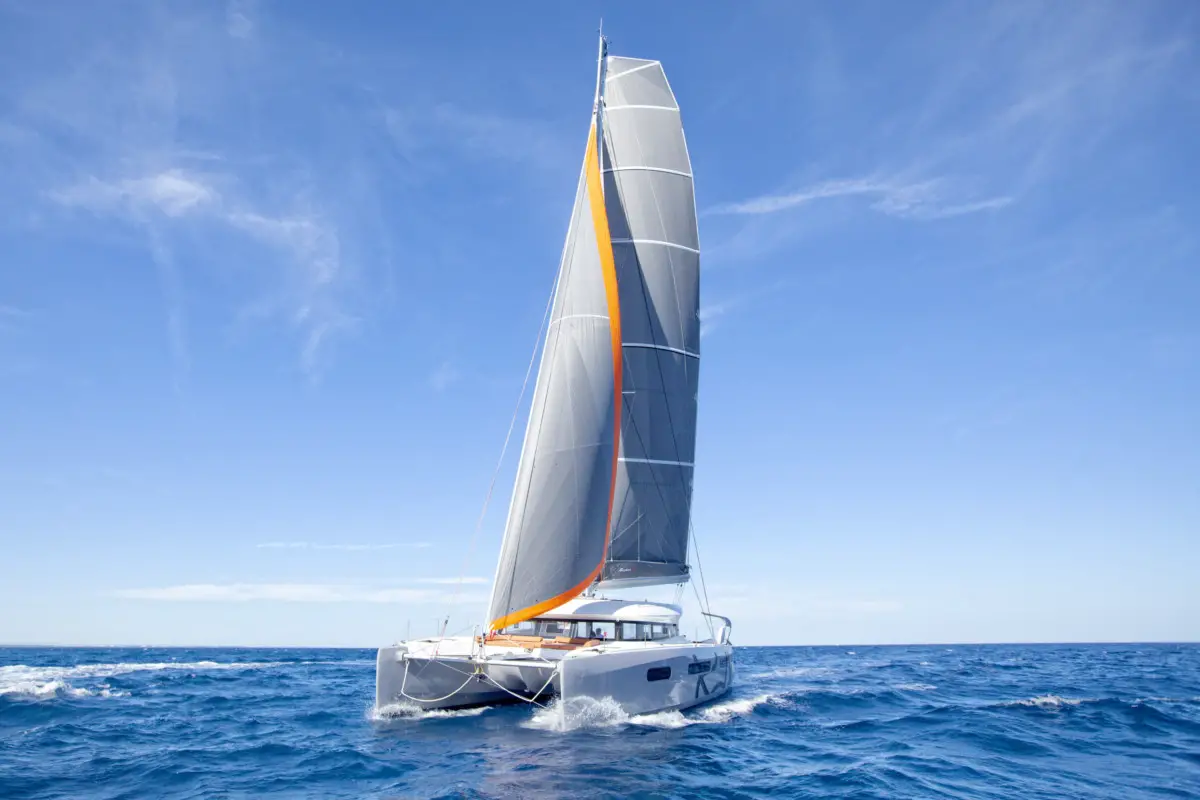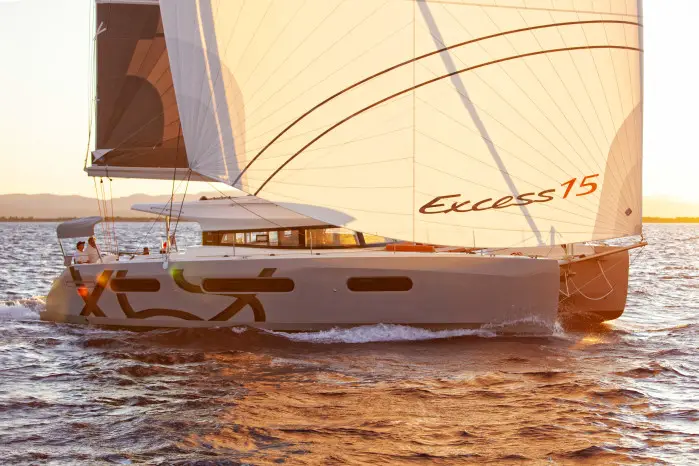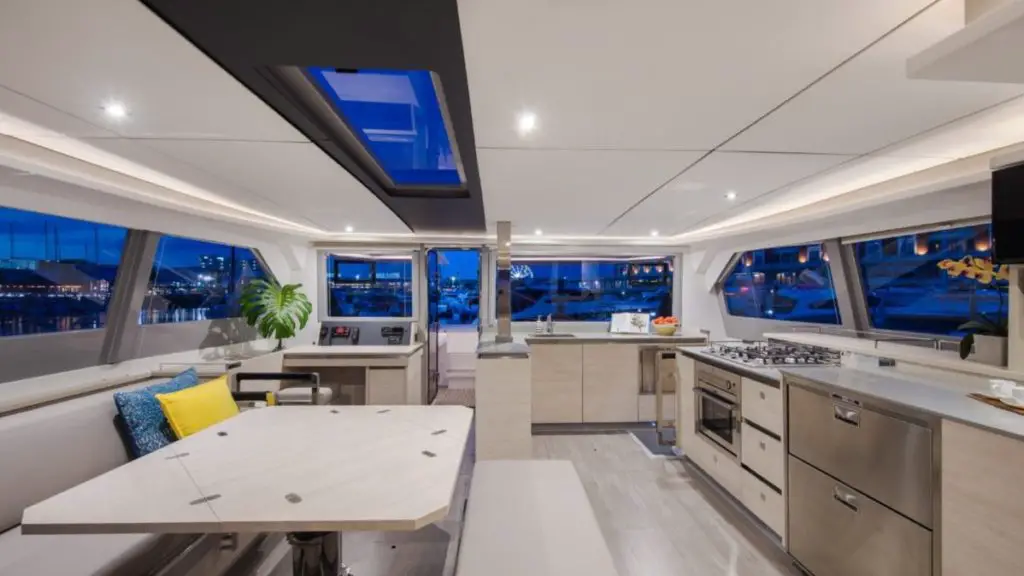As an Amazon Associate, we earn from qualifying purchases. We may also earn commissions if you purchase products from other retailers after clicking on a link from our site.
Buying a boat is a tricky thing, but once you start figuring out what you’re going to use it for things begin to become more apparent. I’m assuming you’re here because you are interested in knowing how small of a sailing catamaran you can get while balancing factors such as price, length, and space. If so, you have come to the right place!
The perfect sized catamaran for ocean sailing (including around the world sailing) is around 40ft; it is small enough to be sailed by one person but big enough to provide safety and speed. Of course, there are many variables to consider, and below we will discuss many of them.
Before we can decide which one is perfect for our needs, we need to look at all ends of the spectrum: the smallest, biggest, cheapest, and most expensive.
What is The Smallest Sized Catamaran for Ocean Sailing?
The size of the smallest suitable catamaran that can safely, and somewhat comfortably, cross big oceans is according to consensus in the sailing community, around 30ft. It is possible with less, but a smaller boat has some real downsides, which I will discuss below.

Anything smaller than 30ft is starting to become too much of a tradeoff. When it comes to dealing with huge waves and strong winds, size is an issue. Too small of a catamaran and every wave appears as a mountain.
It also has a significant effect on the crew; if the boat is never at rest always pitching and yawing it really takes its toll on the team, this will sooner or later impair the crew’s ability to make the right decisions, something that is a must in a situation of crisis.
One of the most significant issues with small catamarans is the low bridge deck clearance; most catamarans make some noise when sailing upwind. These loud noises are due to waves coming towards the boat only to get projected with high speed and force straight into the deck’s underside.
This makes for massive noise and vibration, something that isn’t dangerous but adds to the crew’s fatigue while also making for a horrible trip. There are really only two things that you can do to prevent bridge deck slamming, either you get a big boat with a high bridge deck clearance (more on that here) or you sail downwind.
Usually, fitting all the gear you need for a long trip on the boat is not an issue. But there might be a problem with balancing the ship once you have filled it with all that weight, having weight too far out on either the bow or the stern is a safety issue and can lead to unnecessary pitching and in a worst-case scenario make you dive right into a wave instead of staying on top of it.
Want to know more about how catamarans work? This article explains what a catamaran is! and this article explaines How to sail a small catamaran.
Why is a Bigger Catamaran Better For Sailing Around The World?
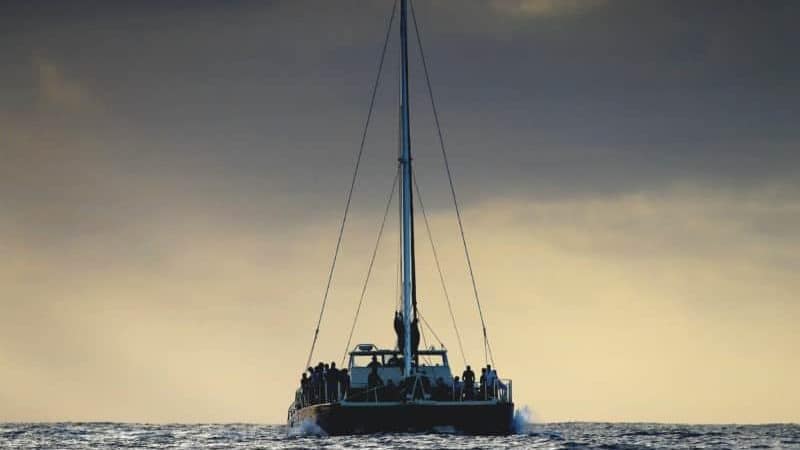
Having a bigger boat offers a lot of advantages, some of them are;
Speed is not only fun, but it is also something that adds to the safety of the trip. If you’re doing ten plus knots instead of just five, that means you will only need half of the time at sea, and if there is a storm on the way, you definitely want to get into safe harbor before it strikes.
To better understand catamaran speed i suggest you read some of my other articles: Catamaran speed explained or Catamaran hull speed calculator.
It also means that you could “outrun” or at least out-steer a storm, so speed gives possibilities and therefore, safety.
Another aspect of speed is how much fun it is:
“Sailing my old 35ft monohull, it was always a slug, slow and steady wins the race they say, we won nothing but boredom, and when you realize that your speed is so slow that on an average jog you would easily outrun your boat, that sucks.”
Gabo
But when you are starting to surf waves and semi-plane, it’s a whole different world; it’s exhilarating, and you go from thinking when is this horrible experience over to thinking, let this never end!
Getting a bigger boat also means a lot more space, and that means more places to store all the fun stuff you want to bring, scuba gear, snorkels, surfing boards, and other fun stuff. Having a smaller boat might mean you won’t have space enough to fill up your dive tanks, so you miss out on many great opportunities.
Another aspect of space is the problem with headroom if you are a tall person and/or you want to bring tall friends onboard then having a saloon where you don’t have to hit your head on the ceiling is a significant factor, and to be honest small catamarans usually don’t have this. This is often not a big issue for short trips, but going on a cruise for multiple days, being comfortable is a big thing.
And speaking of bringing friends along, a bigger boat equals more berths, the bigger ones (40+ft) have full-sized rooms with large beds that are so comfortable that not even grandma will complain, so if you don’t want her to stay for too long, you should probably get a smaller boat.
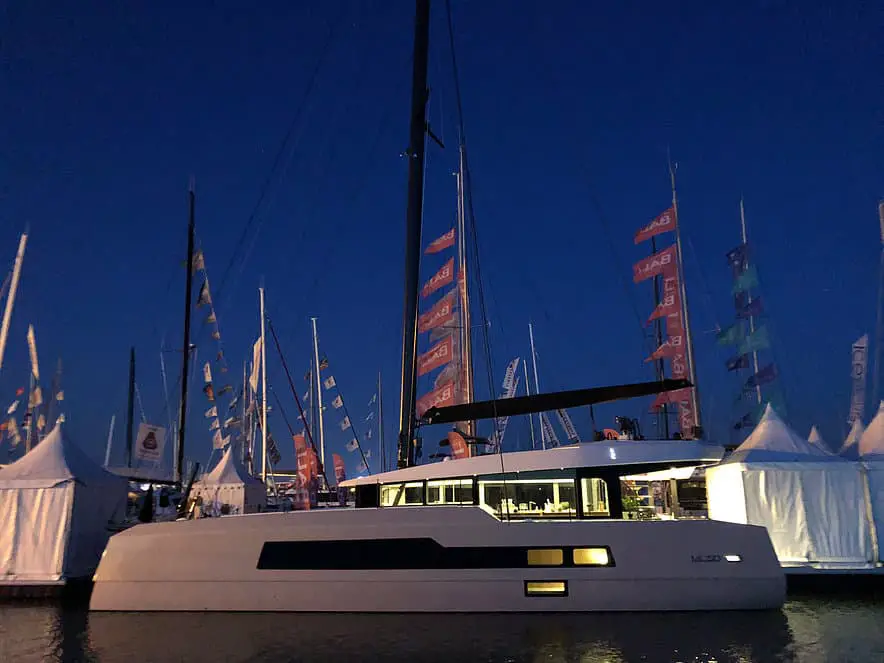
What Sized Catamaran is Too big For Ocean Sailing?
A too big of a catamaran is for most sailors anything longer than 45ft, more specifically a boat which is too expensive, something you can´t handle on your own and that has more space than you need.
This once a little more tricky, a general rule of thumb for many is that you should be able to sail it on your own because you might have to sooner or later.
Bigger boat means sails that are harder to raise and sometimes only possible with an electric winch and having too much electrical stuff are for many a big NO GO. for me it’s not a big deal, just make sure you are able to repair it if it breaks, just like any mechanical system.
A bigger boat means more sail area, which usually means more power, which means higher speeds and sometimes a bit more complicated to handle for a beginner. Make sure you try to get a boat that you are comfortable handling and know precisely how and when to reef.
Since catamarans don’t heel (more on that here) they offer handling-feedback a little bit different, for example since they don’t have deep keels and don’t lean to their side they tend to almost “sit down “a little on their leeward side (the hull of the lee side of the boat).
This sensation can be a little bit awkward at first but is something that the catamaran captain needs to get used to if he or she wants to understand how to properly reef and maintain the sails. If this is not correctly done the catamaran might be at risk of capsizing.
For most people, anything over 45ft is just too much to handle short-handed.
Why do catamarans capsize? I have written a scientific article on the subject here.
Balancing Price and comforts
| Size in ft | Comforts | Maintenance & repair costs | Price | Potential income | Notes |
|---|---|---|---|---|---|
| Up to 30 | Small berths, full height only in hulls. | $ | ~30 000 USD | Not many options | Low bridge deck clearance |
| ~30 | Full height only in hulls, | $ | ~ 60 000 USD | Maybe chartering | Not big, not small |
| ~40 | Full Height in saloon and hulls, large outer deck, | $$ | +150 000 USD | Chartering, AirBnB, paying crew, | Not big, not small |
| Above 45 | Full Height in saloon and hulls, large outer deck, | $$$$ * | +250 000 USD | Chartering, AirBnB, multiple berths, paying crew | Big boat demands an experienced captain |
*Exponentially higher costs since the amount of stuff you have to do usually exceeds the time you will have to fix it. Let’s use bottom paint as an example, you can do it yourself trying to save some money, but since the boat is soo big, you’ll end up spending a lot of work hours painting.
And every day spent hauled out is expensive (especially for such a big boat), so trying to do it yourself might even be more costly than hiring a few workers (since if you are the only one working on the ship it needs to be hauled out for a longer time).

Potential Income From a Bigger Boat
When it comes to the potential income I would argue that the bigger boat you have, the more money you can make, not only could you attract high-paying customers since now you are offering luxury yacht sailing instead of low-end stuff aimed at backpackers. This could be a massive resource of income.
I tried taking people out on my boat, but since it was quite small and not even close to what someone wanted to pay a lot of money for, it didn’t really generate much money.
If you find yourself staying at a marina for a longer time and having a couple of berths available, you could AirBnB those to out to people in the area. This is a great way to make some extra income, and it’s also a great way to make some friends. I would definitely recommend this!
Bigger boats also mean the possibility to have a larger paying crew, instead of not being able to take a single crew person, on a 43ft you could have seven people both working and paying to stay at your boat. That’s a sweet deal and a lot of fun!
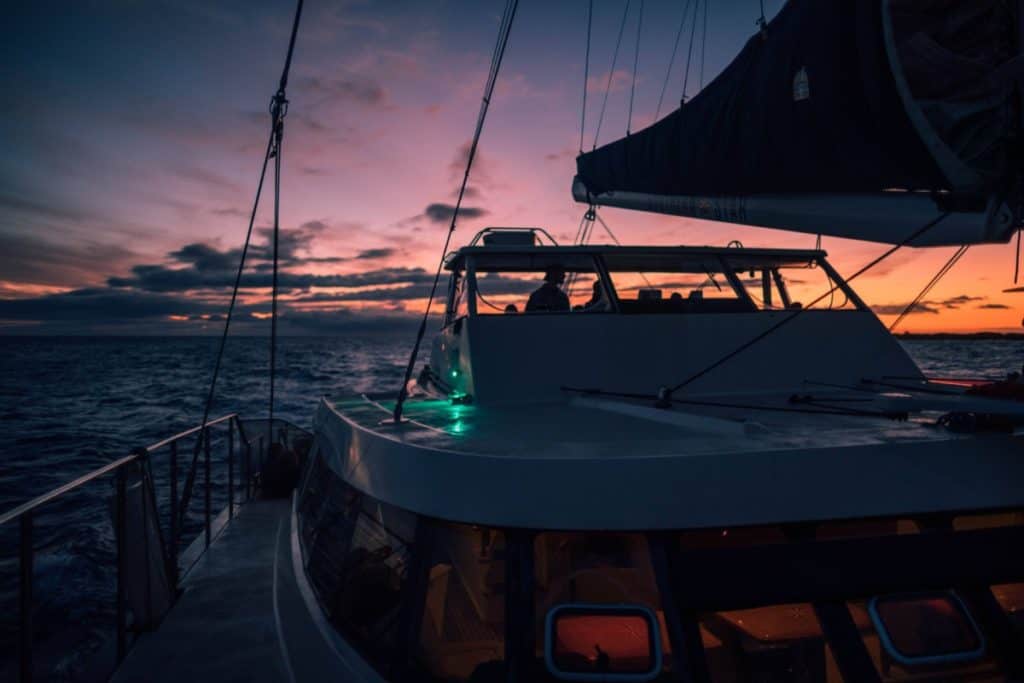
Bigger Boats = Higher Expenses
Size matters; nothing is more accurate in the boating world, but when it comes to the amount of expenses and the size of your pride.
Haul out and placing on stands when it’s time for your repair and maintenance should be thoroughly planned and executed. This is a good tip since you will most definitely pay by the length of your boat, and if you are sailing around in a catamaran, be ready to pay a premium, many times 25 – 50 percent more than the standard price per foot.
So before you take your boat out of the water, make sure you have a solid game plan that includes a rigid timeline of when the contractors should arrive, what the different phases of your maintenance will be, and then push hard to execute according to plan.
If you do it this way there is a lot of money to be saved, what you don’t want to happen is that you have four contractors ready to get to work, but you haven’t bought the paint or the gear needed for the repairs, so they are just sitting around and costing money.
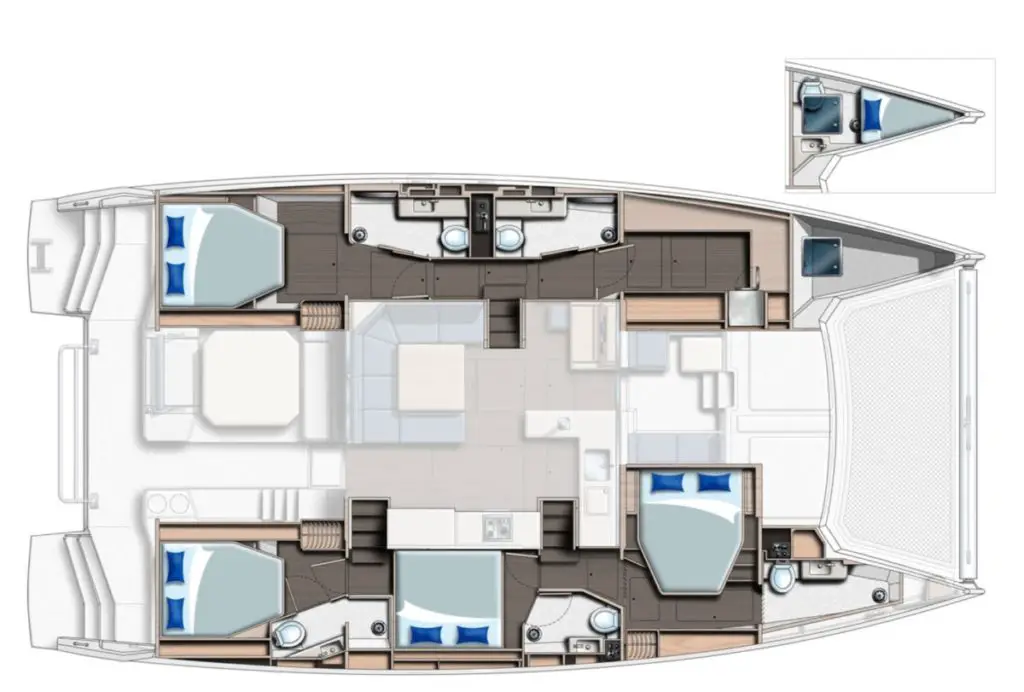
The Best Sized Liveaboard Catamaran
Most ocean-capable catamarans are also more or less suited for living aboard. This means that the best-sized liveaboard catamaran should be around 40-45ft.
When it comes to long-term living on a catamaran, some things are more important than if we only do a single crossing; a liveaboard is about enjoying your house on the water.
In contrast, a catamaran made for hardcore sailing is more about speed and excitement.
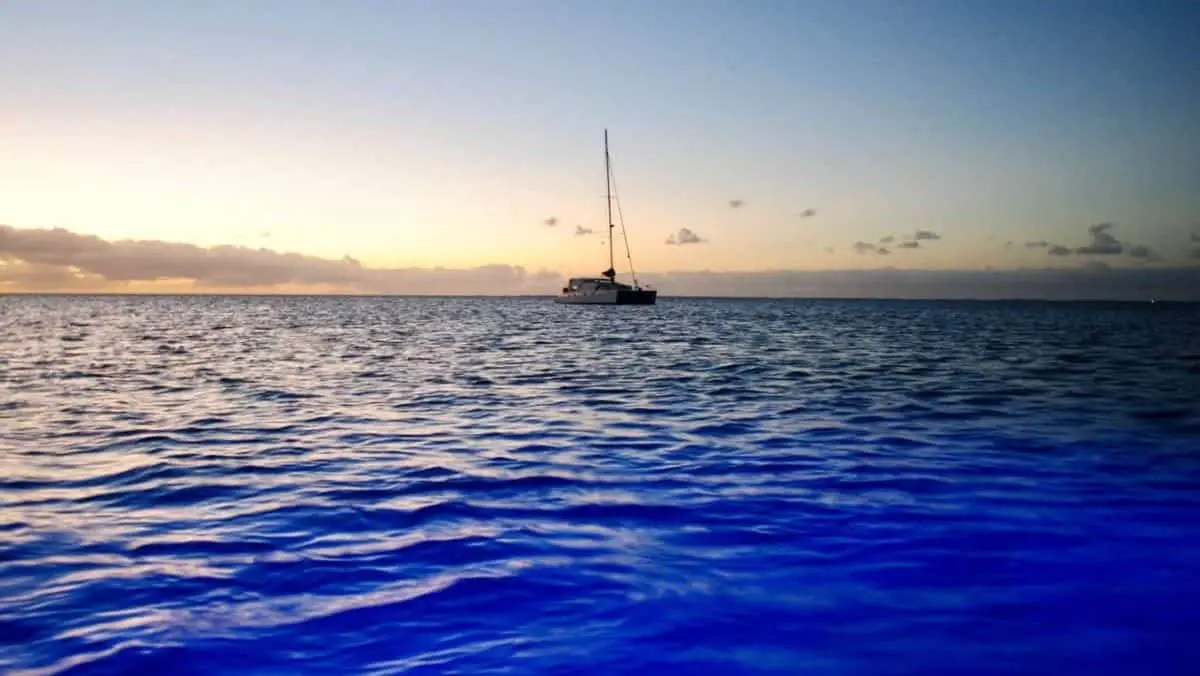
Here is an article i wrote on some of the fastest performance catamarans out there.
Liveaboard-demands usually include a lot of space to store your stuff, wide hulls with large-sized berths, and for many getting a used charter boat is the right decision. Beware when buying an old charter boat that they are usually made for coastal waters, and not all are suited for offshore multiday sailing.
Living on a boat means you will spend a lot of time doing the usual stuff you would also be doing in an ordinary house, including cooking cleaning, and working.
Once you understand your needs there is a better chance you can find a boat that will suit your needs in the long run. Catamarans in the “cruising” category usually have a lot of space to store gear, this means that they have wider hulls.
Having wider hulls creates more drag and will hinder the boat from going as fast as a catamaran with narrow hulls (Check out catamaran hull speed explained).
But having these hulls will greatly improve your comfort since it allows for wider berths(beds) and a boat that is easier to move around in, this might sound like a small thing and you might think that it’s not a big deal. But…
After a couple of weeks sharing a few square feet, every time you bump into someone or something will be a little annoying so I cannot be frank enough when emphasizing how important internal space is when it comes to comfort but also staying good friends with your crew.
If you have an online job, or maybe just a job that you can do from your computer there might also be a need to have a desk or room that is relatively separate and quiet so you can get some work done.
Cruising, Liveaboard, and Ocean Crossing. Guidelines on How to Choose Your Catamaran!
To summarize this article I have put together a shortlist of guidelines that you can use when scouting for a suitable catamaran.
- What is the smallest I can go that still satisfies my needs? This is a great question to ask yourself because, as you have seen above, the smaller you can go, the more money you can redirect into outfitting the boat in a way that you want.
- In a situation where your the only one in “sailable” condition, will you be able to handle the vessel single-handed? Out of a safety perspective, this is very important since you might have to do a man overboard maneuver on your own. This is also a question that only you can answer. If you have a lot of experience and are a very confident sailor, maybe you’ll be okay with a 45ft, but smaller is more appropriate for most people.
- How big of a boat can you afford when including the cost of maintenance, repairs, haul out and all other stuff you have to put money into. Don’t forget BOAT really stands for Break Out Another Thousand.
- When it really comes down to it, do you want speed or space? You can’t have both, unless your filthy rich, then you can have both 🙂
Hope you find this useful! Take care!

